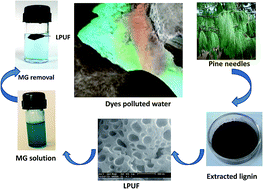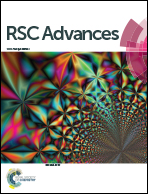New lignin-based polyurethane foam for wastewater treatment†
Abstract
Utilization of renewable feedstock for the development of alternative materials is rapidly increasing due to the depletion of petroleum resources and related environmental issues. Lignin, the second major constituent of lignocellulosic biomass, is catching the attention of researchers for the synthesis of various value-added materials due to its renewable and biodegradable nature, large abundance, non-food value and high functionality. In the present work, lignin was extracted from pine needles, a considerable bio-waste material, and was used as the polyol for the synthesis of polyurethane foam (PUF). The synthesized lignin-PUF (LPUF) was characterized for its physical and thermal properties, and employed as an adsorbent of dyes. The results demonstrated that LPUF is an efficient material to remove a cationic dye, malachite green, and was better in comparison to an anionic dye, methyl orange, from their aqueous solutions. Dye adsorption was a spontaneous and endothermic process. The adsorption kinetics and isotherms fitted well the pseudo second-order model and Langmuir adsorption isotherm, respectively, with a maximum adsorption capacity of 80 mg g−1. In addition, LPUF was reusable for a number of repeat cycles with a cumulative adsorption capacity of 1.33 g g−1 after twenty regeneration cycles.



 Please wait while we load your content...
Please wait while we load your content...